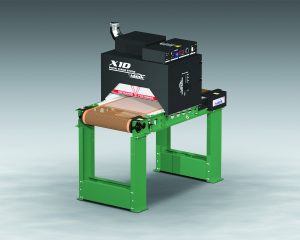
Photo: Vastex
Vastex International has introduced a very small conveyor dryer matched to the output of Anajet, Brother, Epson, Polyprint and other DuPont-based DTG printing systems, depending on model size and image saturation.
Dubbed “LittleRed X1D,” the compact dryer measures 46 x 122 cm (conveyor belt dimensions) and has a heater that spans the entire belt width.
“This is an extremely dense machine engineered to meet the space, budget and performance needs of DTG shops using the most popular inkjets on the market,” says Mr. Vasilantone, president of Vastex. The dryer can cure up to 27 garments per hour DTG-printed with digital white ink, as well as screen-printed garments at rates to 81 per hour for water-based ink or discharge, and 162 per hour for plastisols.
Curing of DTG-printed garments in an infrared conveyor dryer is said to eliminate the flattened, ironed-on appearance and halo associated with heat pressing of printed images, while eliminating the need for an operator to release the press after each cycle. The dryer is also typically employed to dry the pretreatment, relegating the heat press to flattening of raised fibres prior to printing with a one-second ‘touch’ per garment.
As standard this dryer is equipped with features found on the company’s larger DTG-capable dryers including adjustable belt-to-heater clearance to accommodate bulky items, a dual digital PID temperature controller accurate to 1°, and an X-Series conveyor belt roller tracking system with Teflon-coated fibreglass belt. A powered exhaust removes moisture and air contaminants, while cooling the housing and controls.
The heaters of all Vastex dryers carry an industry-leading 15-year warranty and feature closely spaced coils that provide high-density, medium-wavelength infrared heat for maximum cure speed without cold spots or under curing associated with conventional units. The company also offer DTG-capable conveyor dryers in widths up to 198 cm with capacities of up to 185 DTG-printed garments per hour, up to 555 per hour screen printed with water-based ink and discharge and up to 1080 per hour screen printed with plastisol ink.










